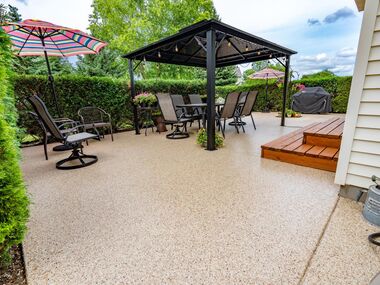Interior Paint Colors: How Light Informs and Affects Your Color Choices

Have you ever painted a room the perfect color only to have it appear less than perfect when the light changes? The problem could be your lighting, your color choice, your paint finish, or some combination of both. In this article, we'll discuss how light affects the color of your interior paint and why you should consider it (along with many other factors) when choosing interior paint colors.
How Lighting Affects Paint Color and Why It Matters
When choosing a color for interior painting, it’s easy to overlook the effect of lighting. But failing to do so can tarnish your results and the way you feel about them. The appearance of the paint in your room will be affected by many factors, including the amount of natural and artificial light, color temperature, etc.
Understanding Natural Light
Natural light is the light generated by the sun, and it changes throughout the day depending on the weather, the sun's position, and more. It enters a building through various openings, like windows and skylights. Letting natural light is a way of keeping indoor space well-lit throughout the day. It reduces the need for artificial lighting and helps you save energy.
You may be wondering how lighting can impact your color choices. Read on to learn more.
The natural light that goes inside your room can affect how your walls’ paint color looks. When there's a lot of natural light in a room, paint colors appear more saturated and vibrant. On the other hand, a lack of natural light can make colors appear dull and less intense. When choosing paint colors, you must consider natural lighting in your space.
Many factors affect the color and amount of natural light that goes into your room. For example, the natural light from the north casts a bluish, cool tint on walls and can make colors look less saturated and darker. But it remains relatively consistent, so the colors in the room stay the same throughout the day. Meanwhile, the natural light that gets into rooms facing south, east, and west tends to change throughout the day. It can shift from intensely reddish or orange in the late afternoon to softer yellowish light in the morning.
Assessing Artificial Light
Sunlight isn’t the only source of light in your home or business. You might rely on LED lights, incandescent bulbs, halogen lamps, and more to illuminate your space in the dark. These light sources may vary in tone, size, intensity, direction, and proximity to your painting surfaces. A wall or ceiling color may look quite different under, above, or next to one of these artificial light sources compared to another. This is why it’s always best to place paint swatches and samples in areas where different types of light hit the surface. That way, you can get a sense of how a single color might look in different lighting scenarios.
Color Temperature Matters
As you compare paint colors for your residential interior painting project, you may come across the terms “cool” and “warm.” These terms are usually associated with temperature, but they refer to aspects of color as well. In this case, temperature describes the type or amount of light reflected by an object. Color temperature is measured in Kelvin’s (K) scale, usually going from 1000k to 10000K. When the light stays below 2000k, it will appear dim (like a candle's light). The light becomes warm yellow when it goes over 2000K but stays below 3000K. Bright white light measures 3100K to 4500K, while bright blueish-white light goes above 4500K.
Warm colors are in the lower end of the scale, while cooler colors are in the higher spectrum. Warm colors include yellows, reds, oranges, while cool colors include blues, greens, and purples.
If you want to make your indoor space more welcoming and appear smaller, warm colors and lighting are the way to go. But if you want to make a room feel more spacious, incorporating cool colors and lighting can help. However, you don’t need to lean heavily in one direction. The key is finding the right balance, implementing cool and warm colors in a given space.
Create Depth With Contrast
Using contrasting colors is a great way to add depth and life to a room. Always consider light when deciding what contrasting colors to use. The darkness and intensity of contrasting colors will change depending on how much natural light enters a room. If you don’t consider light when choosing a contrasting color, you may end up with a room that feels “heavy” in the end.
If you hire an interior designer, they’ll know how to create depth, but if you pick colors yourself, there are a few things to remember. If a small room doesn’t get plenty of natural light, paint most walls white but leave some parts where you can add an eye-catching or striking canvas painting.
Get Creative With Accents
Accent colors can add personality and visual interest to your living spaces. It’s a must, especially if you’re designing an interior around a single hue. Your interior should have at least 10% accent color, as the classic décor rule states.
Don’t go too bold or dark when choosing an accent color. Consider the furniture and other items or designs in your room. Just don’t be afraid to explore. Learn about the color wheel and color theory, as it will be easier to determine which interior paint colors make a great combination.
There are literally thousands of aesthetically pleasing color combinations, like red and gold and purple and pink. Feel free to experiment with different shades. If you don’t know where to start, try using complementary or analogous color schemes. The former sits opposite the primary colors on a color wheel, while the latter refers to colors sitting next to the primary color you’re using in your room.
You can also find color palette generators online nowadays. These tools can help you experiment with color schemes and give suggestions on complementary accent colors. When deciding what color scheme and accents to use for your space, don’t forget to consider lighting and color temperature.
Make a Statement
The color choices you make when painting your home's interior can profoundly impact how you experience and enjoy your living spaces. Understanding the role of natural light and color temperature is essential in making informed decisions.
One last thing to remember before you finally begin your interior painting project: Make a statement. There’s no need to go bold just to make a statement. Even light interior paint colors can make a big impact if you use them correctly. For example, if you have deep wooden materials like dark wood floors in a room, painting the walls white will make the deep and rich colors stand out.
But if you’re okay with bright, saturated colors, there can be countless other ways to make a statement. You can paint your front door with shades of green, red, orange, or yellow. But make sure the color still cohesively harmonizes with the rest of your interior décor.
Evaluate Your Home Layout
Evaluating your home’s layout can makes choosing a color for interior paint easier. Draw a home plan and list what furniture, wall colors, carpet, etc. will be in each room. Collect paint chips or swatches that represent the existing colors in each room. Then assess and write down the negative and positive attributes of each space. Check the list of positive traits and pick a focal point.
Consider the mood you want in a room and the items you want to place there. If you plan to have multiple rooms painted at once, plan one room at a time. To make determining a whole-home color palette easier, consider using a single color of different proportions in every room. For example, use one color as wall paint in one room and as an accent in another.
Find the Best Paint Color with the Help of Anderson Painting Experts!
Our painters at Anderson Painting have spent years perfecting their craft. From picking colors for your space to ensuring quality, professional-looking interior painting, you can rely on the Anderson Painting team.
Ready to upgrade your Raleigh or Wilmington, NC space? Give us a call or fill out our contact form today for more information.



